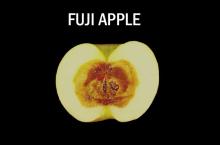Product Description
Maturity and Quality
- Ground color change from green to light-green or white may provide a useful indicator for harvest
- Fruit should be harvested before starch degradation is complete
- Limited research indicates that fruit harvest should occur by 180 to 190 days from full bloom to reduce postharvest disorders (skin cracking and internal browning)
- Research indicates many California Fuji are picked over-mature
- Firmness, crispness, lack of mealiness
- Flavor, including soluble solids, titratable acidity, and flavor volatiles
- Freedom from defects such as bruising, decay, stem or blossom-end cracks, cracks in the skin (checking), bitter pit, insect injury, etc.
- Percent blush on the apple
Postharvest Handling and Storage
0 ± 1°C (32 ± 2°F)
4 to 6 ml/kg·hr at 0°C (32°F)
To calculate heat production multiply ml CO2/kg·hr by 440 to get Btu/ton/ day or by 122 to get kcal/metric ton/day.
- Ethylene can accelerate senescence and loss of firmness
- A reduction in ethylene concentration may reduce susceptibility to scald
90 to 95%
2 to 4 µl/kg·hr at 0°C (32°F)
The following atmospheres have been successful for Fuji apples: <0.5% carbon dioxide (see note), 1.5 to 2.0% oxygen.
- Maintains firmness and acidity
- Reduces susceptibility to bitter pit and storage scald
- Can store up to 8 months in CA
Note: Late harvested Fuji apples (beyond 180 days from bloom) should not be placed in CA storage. Even at 0.5% CO2, internal browning can develop.
Disorders
Storage Scald. Information is incomplete; however, Fuji apples appear to be slightly to moderately susceptible to scald. However, earlier harvested fruit will be more susceptible to scald. DPA may be needed for storage in air for longer than 2 months. CA storage reduces scald incidence.
Bitter Pit. Bitter pit has been observed on a small percentage of fruit. Early harvested, large fruit from young, vigorous trees are most susceptible. Preharvest calcium sprays are most effective to reduce bitter pit. Postharvest calcium dips are also beneficial.
Calcium rates for postharvest dips:
- 2 to 3% solid flakes (77% CaCl2)
- 1.5 to 2% calcium chloride (CaCl2)
- 0.5 to 0.8% calcium ion (Ca+2)
Internal Browning. Browning in the apple flesh as a result of carbon dioxide injury. Keep CO2 in storage below 0.50% and do not place apples harvested beyond 180 days from bloom in CA storage.
Skin Cracking or Checking. Fuji apples appear to be susceptible to skin cracking. The cause is not yet known, however, symptoms increase in severity with delayed harvest.
Core Rot. Fuji is susceptible to core rots, as is its parent, Red Delicious, because of an open calyx tube. Control measures are unknown at this time, but sanitation in the orchard appears to be important.
Gray Mold, Blue Mold.
- Avoid fruit injury
- Sanitize water systems with chlorine
- Cool fruit quickly
Mucor rot. Some orchards have Mucor organisms in the soil. Sanitation to keep soil out of drench water is important. Do not place fruit from the orchard floor into storage bins. Chlorine will not control this organism and there are no effective fungicides. Mucor continues to grow slowly even at 0°C (32°F).
Sanitation of Water Systems
Sanitation of water systems used to handle apples is important to prevent the spread of disease organisms to healthy fruit. Chlorine at 50 to 100 ppm is very effective but the level of available chlorine and solution pH (7.0) must be monitored frequently and adjusted. Sodium will accumulate when liquid sodium hypochlorite is used and can burn apple tissues. We recommend water systems be changed once a day to reduce the risk of burn to apple skins. Gala is very sensitive to sodium burn.
References
For more information, see our publication "Fruit Ripening and Ethylene Management" available for purchase using our Publication order form.








